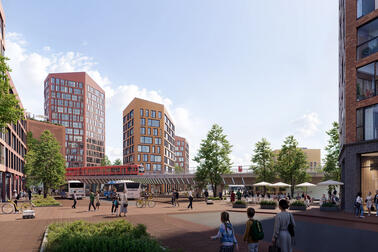
This autumn, Helsinki will decide whether Kaivokatu in the city center will be reserved for walking, public transport, pick-up and drop-off traffic, as well as recreation. This is one of the changes proposed in the transport system plan for the city centre.
According to the proposal, the surroundings of the Helsinki Central Railway Station will be developed into a more attractive street environment, including new services, plantings and terraces. After the reforms, the surroundings of the central railway station would become an integral part of the pedestrian center.
Improving walkability in the center
According to the proposal, passenger cars would be banned from passing through Kaivokatu, but they could drive through the city centre via the Pohjoisesplanadi and Eteläesplanadi streets. Both streets would have two lanes.
The traffic system plan also proposes more extensive improvements to the city center's local street network. The aim of the development is to improve walkability, and to develop the attractiveness of business premises in a positive way.
“Helsinki is developing the city centre into a place where people want to come to and experience things. In order for the city centre to remain vital and provide more extensive services, it must attract people to spend time there and enjoy themselves. We want to be an internationally competitive metropolis in this regard as well,” says Ville Lehmuskoski, Head of the Urban Environment Division in Helsinki.

Vitality impacts have been assessed
In 2021, the Helsinki City Board decided that the pedestrian centre and a walkable centre would be expanded ambitiously. The transport system plan and the supporting environmental plan have been drawn up to promote this objective.
The planning has paid particular attention to ensuring that transport reforms support the vitality of the city centre, and that the area’s services will be increasingly accessible through public transport. Public transport connections are to be improved, especially near the central railway station and the Kamppi terminal.
If the plan is implemented, all properties in the city centre will remain easily accessible by car. A major reform would be that all underground parking facilities connected to the central service tunnel would be accessible via all the entrances. This possibility is currently being planned.
Despite this, the most negative impacts of the new traffic arrangements would affect service and delivery traffic, as well as those who want to drive through the city centre by car. For these groups, the changes would be reflected in longer travel times.
“The assessment indicates that implementing the plan would still create more positive than negative vitality impacts for Helsinki. For the majority of people coming to the city centre, travel times would shorten. On the whole, the reform would strengthen the vitality of the city centre. The impacts of the implementation of the transport system plan have been extensively assessed with various stakeholders and with the help of studies,” says Director of Traffic and Street Planning Reetta Putkonen.
Reforms of Kaivokatu surroundings could be completed in 2030s
If the Urban Environment Committee approves the transport system plan for the city centre, it will be submitted for decision by the City Board later in the autumn.
After this, the reforms would still require a lot of planning. The reforms may enter into force mainly in the first half of the 2030s.
Before that, the plan is to renovate the roof of the metro station on Kaivokatu, and to implement the light rail arrangements planned for the area.


